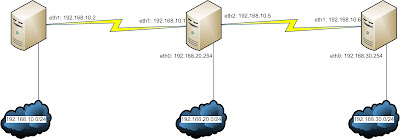Quagga OSPF Simulation in CentOS 6
 |
| Scenario |
This article is actually a modified version of a previous article
IP Details
All the Routers in the diagram are actually CentOS Machines.- eth0: 192.168.10.254/24
- eth1: 10.0.0.2/30
- eth0: 192.168.20.254/24
- eth1: 10.0.0.1/30
- eth2: 10.0.0.5/30
- eth0: 192.168.30.254/24
- eth1: 10.0.0.6/30
Objective
We would be configuring the Linux boxes with dynamic routing protocol OSPF for total connectivity. This would be done with the help of Quagga.Router Alpha Configuration
root@alpha:~# yum install quaggaWe would be configuring the interface parameters. Keep in mind, there are example configuration files stored in /usr/share/doc/quagga/
root@alpha:~# cd /etc/quagga
root@alpha:/etc/quagga# cat zebra.conf.sample > zebra.conf
root@alpha:/etc/quagga# vim zebra.conf
hostname
AplhaRouter
password
zebra
enable
password zebra
!
!
Interface's description.
!
interface
lo
description
loopback
ip
address 127.0.0.1/8
ip
forwarding
interface
eth0
description
LAN
ip
address 192.168.10.254/24
ip
forwarding
interface
eth1
description
to_beta
ip
address 10.0.0.2/30
ip
forwarding
log
file /var/log/quagga/zebra.log
Now to the OSPF Configuration.
root@alpha:/etc/quagga# cat ospf.conf.sample > ospf.conf
root@alpha:/etc/quagga# vim ospfd.conf
###
we define the interfaces that take part in OSPF
interface
eth0
interface
eth1
router ospf
network
10.0.0.0/30 area 0
network
192.168.10.0/24 area 0
log
stdout
log
file /var/log/quagga/ospfd.log
root@alpha:/etc/quagga# /etc/init.d/zebra restart
root@alpha:/etc/quagga# /etc/init.d/ospfd restart
root@alpha:/etc/quagga# chkconfig zebra on
root@alpha:/etc/quagga# chkconfig ospfd on
vtyshprovides a shell that resembles the CISCO IOS shell. It even supports commands from the CISCO IOS.
root@alpha:~#vtysh
Hello, this is Quagga (version 0.99.17).
Copyright 1996-2005 Kunihiro Ishiguro, et al.
AlphaRouter# show ip route
Codes: K - kernel route, C - connected, S - static, R - RIP, O - OSPF,
I - ISIS, B - BGP, > - selected route, * - FIB route
C>* 127.0.0.0/8 is directly connected, lo
C>* 10.0.0.2/30 is directly connected, eth0
C>* 192.168.10.0/24 is directly connected, eth1
AlphaRouter# exit
We can issue commands like show ip route or show ip ospf in vtysh to check the available routes and OSPF status. However, since there are no OSPF neighbors yet, the show ip route should show only directly connected devices.
Here is a sample output of quagga log from one of my Quagga Routers.
[root@firefly ~]# tail -f /var/log/quagga/ospfd.log
2012/04/15 15:13:53 OSPF: DR-Election[1st]: DR 192.168.1.2
2012/04/15 15:13:53 OSPF: DR-Election[2nd]: Backup 192.168.1.3
2012/04/15 15:13:53 OSPF: DR-Election[2nd]: DR 192.168.1.2
2012/04/15 15:13:53 OSPF: ospfTrapIfStateChange trap sent: 192.168.1.3 now Backup
2012/04/15 15:13:53 OSPF: interface 192.168.1.3 [3] join AllDRouters Multicast group.
2012/04/15 15:13:53 OSPF: DR-Election[1st]: Backup 192.168.1.3
2012/04/15 15:13:53 OSPF: DR-Election[1st]: DR 192.168.1.2
2012/04/15 15:13:53 OSPF: Packet[DD]: Neighbor 10.0.0.1: Initial DBD from Slave, ignoring.
2012/04/15 15:13:53 OSPF: Packet[DD]: Neighbor 10.0.0.1 Negotiation done (Master).
2012/04/15 15:13:53 OSPF: nsm_change_state(10.0.0.1, Loading -> Full): scheduling new router-LSA origination
Router Beta Configuration
Time to configure the next Linux box. The configuration is identical except for the network parameters. Here it goes -
root@beta:/etc/quagga# cat zebra.conf
hostname
BetaRouter
password
zebra
enable
password zebra
!
!
Interface's description.
!
interface
lo
description
loopback
ip
address 127.0.0.1/8
ip
forwarding
interface
eth0
description
LAN
ip
address 192.168.20.254/24
ip
forwarding
interface
eth1
description
to_alpha
ip
address 10.0.0.1/30
ip
forwarding
interface
eth2
description
to_gamma
ip
address 10.0.0.5/30
ip
forwarding
log
file /var/log/quagga/zebra.log
root@beta:/etc/quagga# cat ospfd.conf
###
we define the interfaces that take part in OSPF
interface
eth0
interface
eth1
interface
eth2
router
ospf
network
10.0.0.0/30 area 0
network
10.0.0.4/30 area 0
network
192.168.20.0/24 area 0
log
stdout
log
file /var/log/quagga/ospfd.log
root@beta:/etc/quagga# /etc/init.d/zebra restart
root@beta:/etc/quagga# /etc/init.d/ospfd restart
root@beta:/etc/quagga# chkconfig zebra on
root@beta:/etc/quagga# chkconfig ospfd on
root@beta:~#vtysh
Hello, this is Quagga (version 0.99.17).
Copyright 1996-2005 Kunihiro Ishiguro, et al.
BetaRouter# show ip route
Codes: K - kernel route, C - connected, S - static, R - RIP, O - OSPF, I - ISIS, B - BGP, > - selected route, * - FIB route
C>* 127.0.0.0/8 is directly connected, lo
O 10.0.0.1/30 [110/20] is directly connected, eth1
C>* 10.0.0.1/30 is directly connected, eth1
O 10.0.0.5/30 [110/20] is directly connected, eth2
C>* 10.0.0.5/30 is directly connected, eth2
O>* 192.168.10.0/24 [110/40] via 10.0.0.2, eth1,
O 192.168.20.0/24 [110/20] is directly connected, eth0
C>* 192.168.20.0/24 is directly connected, eth0
BetaRouter# exit
As we can see now,
the neighbor relationship has been formed and Alpha and beta have
already exchanged routing information.
Now try pinging
between the Alpha and Beta networks. Should work. Alternatively, also
using the good old route
command as well to see whether the routes are already being learnt.
Router Gamma Configuration
The configuration of Gamma is same as the previous Linux boxes.root@gamma:/etc/quagga# cat zebra.conf
hostname
GammaRouter
password
zebra
enable
password zebra
!
!
Interface's description.
!
interface
lo
description
loopback
ip
address 127.0.0.1/8
ip
forwarding
interface
eth0
description
LAN
ip
address 192.168.30.254/24
ip
forwarding
interface
eth1
description
to_beta
ip
address 10.0.0.6/30
ip
forwarding
log
file /var/log/quagga/zebra.log
root@gamma:/etc/quagga# cat ospfd.conf
###
we define the interfaces that take part in OSPF
interface
eth0
interface
eth1
router
ospf
network
10.0.0.4/30 area 0
network
192.168.30.0/24 area 0
log
stdout
log
file /var/log/quagga/ospfd.log
root@gamma:/etc/quagga# /etc/init.d/zebra restart
root@gamma:/etc/quagga# /etc/init.d/ospfd restart
root@gamma:/etc/quagga# chkconfig zebra on
root@gamma:/etc/quagga# chkconfig ospfd on
The system is now
ready to rumble. Try viewing the routes by route or ip route or show
ip route (vtysh). All the routers should be able to ping each
other, and each host from any of the LANs should be able to
communicate with host of other LAN. Again, traceroute
can also be used to check the path that is being taken by a packet.
Hope it helps.
Mr. Sarmed Rahman
ReplyDeleteRecently, I used this manual and works fine. Thanks.
Can I use It for republish for publish it in an University Course blog?
Good to hear that you found the document helpful. Sure you can republish it in the University Course blog. Mentioning the source would be nice though.
DeleteI had 12 Network and want to add BGP with AS numbers 12 on SAME router is it possible to add more than 1 network on server ?
ReplyDeleteRecently using Vyatta and it is only using one at a time.